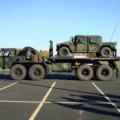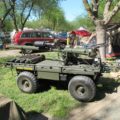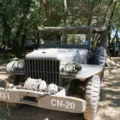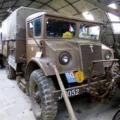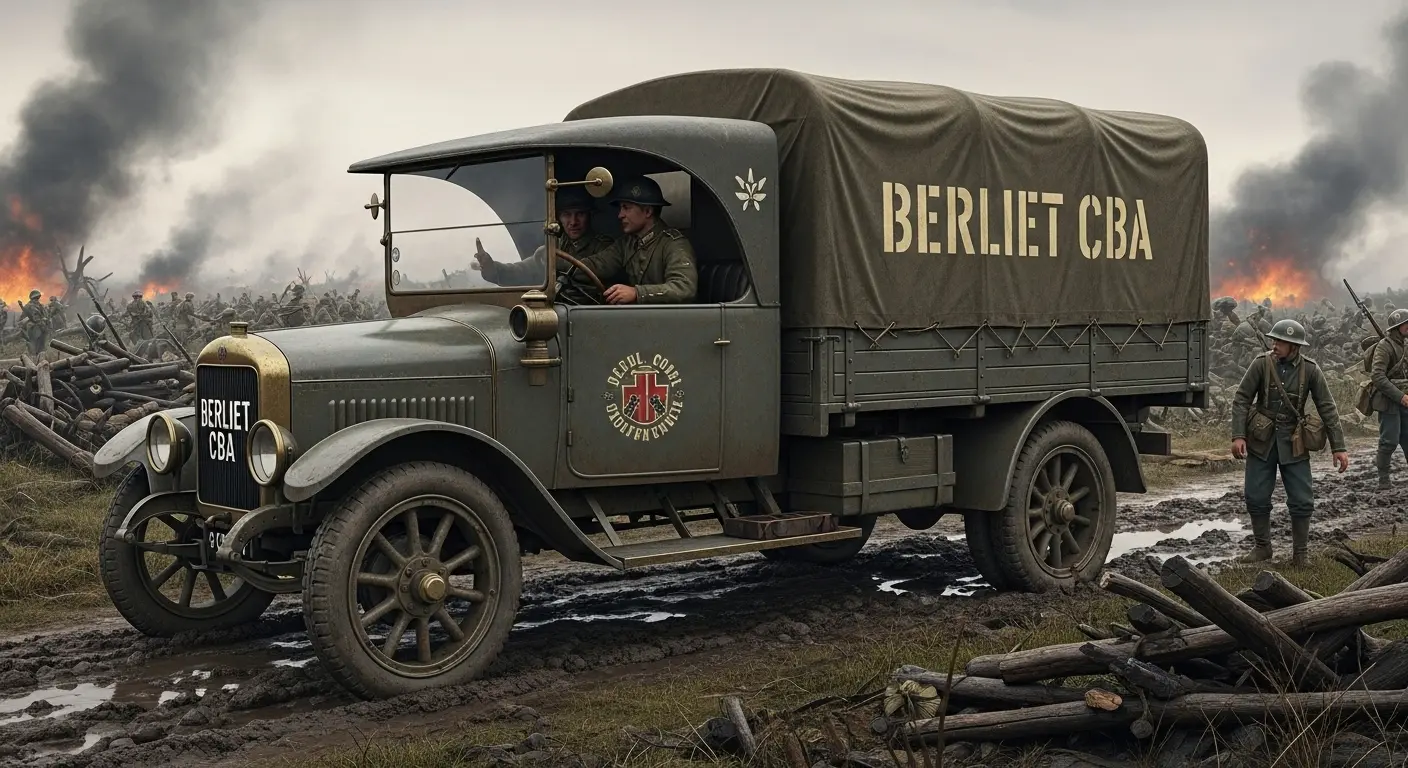
Berliet CBA |
|
|---|---|
| Pays | France |
| Type | Camion |
| Production | 1913–1932 |
| Construit | Inconnu |
Lla Berliet CBA is a series of medium-duty trucks with chain drive, initially for the military and later also for commercial use. It was produced by the French manufacturer Berliet from 1913 to 1932, and was one of the most used trucks in World War I. It was replaced by the Berliet GD series.
Source: Wikipedia
| Berliet CBA Walk Around | |
|---|---|
| Photographe | Unknow |
| Localisation | Inconnu |
| Photos | 72 |
Wait, Searching Berliet CBA for you…

Voir aussi :
The Berliet CBA: A Definitive Historical and Technical Analysis of the Iconic French World War I Truck
1. Introduction: Genesis and Historical Context
The Berliet CBA represents a series of medium-weight, chain-drive trucks that played a fundamental role in French automotive and military history. Produced by the French manufacturer Berliet from 1913 to 1932, it quickly became one of the most widely used trucks during World War I. Its robust design and mass production efforts not only contributed significantly to the modernization of military logistics but also established Berliet as a key industrial player in France. The development of the CBA in 1913, just before the outbreak of World War I, occurred in a context where the French army had only about 900 trucks of all types. The rapid onset of war in August 1914 and the immediate demand for efficient troop and material transport prompted the French army to order mass production of the CBA. This situation demonstrates a strategic foresight by Berliet or military authorities, anticipating the need for robust transport. France’s « rapid and effective » response to wartime material losses, with the quick conversion of factories to mass production, illustrates a highly efficient industrial mobilization strategy. The CBA was not just a truck; it embodied France’s ability to rapidly adapt its industrial base to meet unprecedented wartime demands. The dramatic increase in the French army’s truck fleet, from approximately 900 vehicles to over 90,000 by the end of World War I, with the Berliet CBA as a major contributor (over 40,000 units produced), marked a profound transformation in military logistics. This was not merely about replacing horses; it was a demonstration of the indispensable role of motorized transport in large-scale modern conflicts. The CBA, as a reliable and mass-produced workhorse, fundamentally proved the viability and necessity of automotive industrialization for military success, setting a precedent for future mechanized warfare.2. Production History and Evolution (1913-1932)
Production of the Berliet CBA began in 1913 and continued until 1932. Assembly was primarily carried out in France, at Berliet’s factories in Lyon and Vénissieux. The Monplaisir factory, employing 7,000 people, was essential in manufacturing CBA chassis during World War I. Mass production began in August 1914, following the outbreak of World War I, in response to the urgent transport needs of the French army. By 1918, the production rate of CBA trucks reached an impressive 40 units per day, demonstrating Berliet’s industrial capacity and its crucial contribution to the war effort, particularly at Verdun. Production continued for some time after the war, supplying both the French army and civilian customers. However, post-war, in 1919-1920, military orders abruptly ceased due to a market flooded with surplus vehicles from both the French and American armies. Despite this, Berliet remained an important supplier to the French army during the rearmament period. Regarding total production volume, one source indicates over 9,000 units produced from 1914, while more comprehensive data suggests over 40,000 units were produced throughout its career, from 1913 to 1932. Given the mentioned daily production rates (40 units per day in 1918) and a production period of nearly two decades, the figure of 40,000 seems more plausible for total production. The 9,000 figure might represent initial military contracts or production of a specific variant, while the 40,000 figure encompasses the entire production lifecycle, including civilian and post-WWI military sales. This indicates a sustained, high-volume manufacturing capability that extended well beyond immediate wartime demand, demonstrating the truck’s lasting utility and commercial success. The cessation of military orders in 1919-1920 due to a saturated market highlights a major economic challenge for manufacturers like Berliet after the war. Nevertheless, the continuation of production until 1932 and the shift towards civilian sales with design improvements like windscreens and rearview mirrors demonstrate Berliet’s adaptability. This indicates a successful transition from a wartime economy to a peacetime commercial market, showcasing the company’s resilience and the fundamental utility of the CBA design beyond military applications. The fact that Berliet remained a significant military supplier during rearmament further illustrates its long-term strategic importance to the French state. Early CBA vehicles, built in 1913, featured basic designs. The first models lacked glass windscreens, with the only weather protection being a large canvas roof stretched over a frame. In 1919, newly built CBAs received a significant cabin update: sheet metal paneling on a hardwood frame, the addition of a left-side door, and a tarred cloth roof stretched over a wooden frame. Further improvements appeared in 1923, when new CBAs were fitted with a windscreen and a rearview mirror, primarily for civilian customers. The Berliet CBA series and its derivatives were gradually replaced by the Berliet GD series, which began production in 1926 and continued until 1953. A key technological advancement of the GD series was the adoption of universal joint transmissions, moving away from the CBA’s characteristic chain-drive system. The GD series was designed as a medium/heavy commercial vehicle chassis, marking a technological evolution in Berliet’s truck offerings.3. Fundamental Technical Specifications
The Berliet CBA, as a utility vehicle of its era, featured a series of technical specifications that evolved throughout its production period.Engine and Performance
Early CBA vehicles, built in 1913, were fitted with an inline four-cylinder petrol engine, designated by the code ‘L’. This engine had a bore of 100 mm and a stroke of 140 mm, resulting in a displacement of 4,398 cm³. Its power was 22 fiscal horsepower (CV). Subsequently, CBAs delivered from 1923 onwards were equipped with an engine coded ‘Z17’. While retaining the previous dimensions (likely bore and stroke, implying similar displacement), its nominal power increased to 24 CV, reaching its maximum power at 1,400 rpm. The Berliet CBAB model, produced from 1925/1926, used an engine coded ‘MLB4’. This engine was rated at 20 CV at 1,300 rpm, suggesting a slight readjustment or different power curve compared to the Z17, despite a potentially similar underlying architecture. The progression of engine codes (L, Z17, MLB4) and slight variations in fiscal horsepower (22 CV, 24 CV, 20 CV) over the CBA’s production lifespan, despite similar dimensions, indicate a continuous refinement process rather than a radical redesign. This suggests an iterative engineering approach, likely focused on optimizing efficiency, reliability, or specific performance characteristics (e.g., peak power RPM) within existing design constraints. The slight decrease in fiscal horsepower for the MLB4 engine in the heavier CBAB might indicate a trade-off for durability or torque at lower RPMs, which is crucial for a heavier vehicle with a slightly lower payload. Some later derivatives, such as the Berliet GD series (which replaced the CBA), used an MDB engine, rated at 28 CV with an actual power of 55 metric horsepower (40 kW). This indicates a progression towards more powerful engines within Berliet’s truck ranges.Chassis, Transmission, and Tires
The CBA featured a front-engine, rear-wheel drive layout. A defining characteristic of the CBA series was its chain-drive system for the rear wheels. This was a common technology for heavy vehicles of its time, but it was eventually replaced by universal joint transmissions in later models like the GD series. Tire specifications for the CBAB variant included solid rubber tires, with front tires measuring 1,030 mm x 140 mm and dual rear tires measuring 1,030 mm x 160 mm. The use of solid rubber tires reflects the available technology for heavy vehicles at the time, prior to the widespread adoption of pneumatic tires for such applications. The continued reliance on chain drive and solid rubber tires throughout much of the CBA’s production, even as the GD series introduced universal joints and pneumatic tires became available (as suggested by their absence on Ursus copies), marks a period of technological transition. While chain drive was robust for its era, its eventual replacement by universal joints in the GD series underscores its obsolescence. The fact that copies like the Polish Ursus trucks were quickly discontinued due to lacking « more modern technology of floating axles, shaft drive and pneumatic tires » directly highlights the limitations of the basic CBA design in the face of advancing automotive engineering. This positions the CBA as a product of its time, effective but ultimately superseded by more efficient and comfortable technologies.Dimensions, Weight, and Payload Capacities
The standard CBA (post-1923) had a curb weight of 3,840 kilograms (8,470 lb) and a payload capacity of 4 tonnes. The wheelbase was extended by 5 mm, and the cargo area was expanded. The Berliet CBAB variant (from 1925/1926) had a curb weight of 5,131 kilograms (11,312 lb) and a payload of 3.5 tonnes. Its wheelbase was 4.19 meters, and the cargo area measured 3.80 x 1.85 meters. The 4-tonne payload capacity is consistently highlighted as a key feature, making it suitable for heavy transport during World War I. The following table summarizes the key technical specifications of the Berliet CBA variants, offering a structured overview of its technical evolution: Table 1: Key Technical Specifications of Berliet CBA Variants| Variant/Period | Production Years | Engine Type/Code | Displacement (cm³) | Fiscal Horsepower (CV) | Max Power RPM | Chassis Layout | Curb Weight (kg/lb) | Payload (tonnes) | Wheelbase (m/mm) | Cargo Area Dimensions (m) | Tire Type/Dimensions |
| Early CBA | 1913–~1915 | L | 4,398 | 22 | N/A | Front-engine, rear-wheel drive, chain drive | N/A | N/A | N/A | N/A | N/A |
| CBA Post-1923 | 1923–1926 | Z17 | 4,398 | 24 | 1,400 | Front-engine, rear-wheel drive, chain drive | 3,840 (8,470) | 4 | N/A (+5 mm) | Expanded | N/A |
| Berliet CBAB | 1925/1926–1932 | MLB4 | N/A | 20 | 1,300 | Front-engine, rear-wheel drive, chain drive | 5,131 (11,312) | 3.5 | 4.19 | 3.80 x 1.85 | Solid rubber: Front 1030×140, Dual Rear 1030×160 |
| CBAC (1932) | 1932 | Petrol | N/A | N/A | N/A | Front-engine, rear-wheel drive, chain drive | N/A | N/A | N/A | N/A | N/A |
| GCM | Late 1920s | N/A | N/A | 24 | N/A | Front-engine, rear-wheel drive, chain drive | N/A | 7.5 | N/A | N/A | N/A |
| GCE | Late 1920s | N/A | N/A | 20 | N/A | Front-engine, rear-wheel drive, chain drive | N/A | 7.5 | N/A | N/A | N/A |
| GPC | Late 1920s | N/A | N/A | 20 | N/A | Six-wheeler, chain drive | N/A | 10 | N/A | N/A | N/A |
4. Variants and Applications: Military and Civilian Roles
The Berliet CBA was not merely a transport vehicle but a versatile platform adapted for a multitude of roles, both military and civilian.Primary Military Applications
The CBA’s primary military role was the transport of troops and materiel, a function it extensively fulfilled during World War I. Its robust design made it suitable for the harsh conditions of the front. Beyond general transport, the CBA was adapted into specialized military variants:- Medical Troops: Versions with a wooden body were used for sterilization, radiology, and general transport of medical personnel and equipment.
- Anti-Aircraft Defense: Some CBAs were fitted with machine guns for anti-aircraft roles.
- Towing: They served as towing vehicles for lighter trailers.
- Artillery Support: From 1918 onwards, various CBAs were used by motorized field artillery regiments, capable of transporting a gun and ammunition on their loading area.
Transition to Civilian Use Post-World War I
Thousands of CBA units were supplied to civilian customers during and after World War I. After demobilization, a significant number of military CBAs found their way into civilian life. After 1923, newly delivered CBAs, featuring cabin improvements like windscreens and rearview mirrors, were primarily sold to civilian customers, although a notable 449 units were still delivered to the French army between 1924 and 1926.Description of Later Derivatives
The Berliet CBAB was produced from 1925/1926 to 1932, with the vast majority going to civilian customers (only 37 ordered by the army). It retained the chain drive and solid rubber tires but had a higher curb weight and slightly reduced payload compared to the earlier 4-tonne CBA. In 1928, two CBABs fitted with gasifiers were delivered to the army under the designation CBAG. This highlights experimentation with alternative fuels. In 1932, the French army ordered 14 CBACs with petrol engines for multipurpose transport. By the late 1920s, Berliet had developed a full range of medium-duty, chain-drive truck chassis derived from the CBA, indicating the versatility and fundamental nature of the original design:- GCM: 7.5 tonnes payload, 24 CV.
- GCE: 7.5 tonnes payload, 20 CV.
- GPC: Six-wheeler, 10 tonnes payload, 20 CV.
| Variant Name | Primary Production Period | Key Features/Distinctions | Payload (tonnes) | Primary Application | Key Military/Civilian Sales Figures |
| Berliet CBA | 1913–1932 | Medium truck, chain drive | 4 | Military: Troop and material transport, medical, anti-aircraft, towing, artillery; Civilian: General cargo | Over 40,000 units total; Over 9,000 for the army |
| CBD | 1913 | Forward-control version | N/A | Military: Testing | N/A |
| CBAB | 1925/1926–1932 | Chain drive, solid rubber tires | 3.5 | Civilian (majority); Military (limited) | 37 units for the army |
| CBAG | 1928 | CBAB with gasifier | 3.5 | militaire | 2 units |
| CBAC | 1932 | Petrol engine | N/A | Military: Multipurpose transport | 14 units |
| GCM | Late 1920s | CBA derivative, chain drive | 7.5 | N/A | N/A |
| GCE | Late 1920s | CBA derivative, chain drive | 7.5 | N/A | N/A |
| GPC | Late 1920s | Six-wheeler, chain drive | 10 | N/A | N/A |
5. Distinctive Features and Design Innovations
The Berliet CBA was distinguished by several operational and design characteristics that reflected the technologies and priorities of its era.Unique Operational Features
A particularly distinctive and unusual feature for a vehicle of French origin was the right-hand drive configuration of the Berliet CBA. This design choice is notable in the context of early automotive standardization. Operationally, the CBA did not feature conventional pedals for control. Instead, large handles located on the right side of the driver’s compartment served as the primary levers for the brake, gas, and transmission. This mechanical control system reflects the early stage of automotive ergonomics and design. The presence of right-hand drive and the absence of pedals, with a reliance on large manual handles, underscore the experimental and non-standardized nature of early automotive ergonomics. This suggests that drivers of the era had to adapt significantly to various control configurations. The later addition of a door, windscreen, and rearview mirror marks a progressive evolution towards greater driver comfort, safety, and practicality, driven by both military requirements (durability) and civilian market demands (ease of use). This transition reflects a broader trend in automotive design, moving from purely functional, mechanically driven interfaces to more user-centric and standardized controls.Early Design Features and Improvements
Early CBA models were quite rudimentary in terms of driver comfort and protection, with only a large canvas roof stretched over a frame providing shelter from the elements, and no glass windscreen. Later improvements included the addition of a left-side door and a more robust cabin structure with sheet metal paneling on a hardwood frame in 1919. By 1923, a windscreen and rearview mirror were integrated, significantly enhancing driver visibility and safety. The radiator was protected by a device described as a « bull-bar, » mounted on the forward-protruding chassis, which also served as an attachment point for the large, round headlights. This indicates an early consideration for vehicle durability and protection in harsh environments. The radiator’s protection by a « bull-bar » and the robust chain-drive system highlight a design philosophy prioritizing durability and mechanical simplicity over driver comfort or advanced features. This approach was entirely appropriate for a truck designed for the challenging conditions of World War I battlefields and early commercial transport, where reliability and load-carrying capacity were paramount. The absence of pneumatic tires further reinforces this focus on robustness and simplicity, even at the expense of ride comfort or speed, reflecting the technological limitations and operational priorities of its time.6. Historical Importance and Impact
The Berliet CBA played a pivotal role in history, particularly as a cornerstone of logistics during World War I and beyond.Crucial Role in World War I Logistics
The Berliet CBA was not merely a transport vehicle; it was a « major instrument of French victory » during World War I. Its mass production was a direct response to the urgent need for military transport. It particularly distinguished itself on the « Voie Sacrée » (Sacred Way) during the Battle of Verdun, where it played an essential role in continuously transporting men and equipment to the front. The daily production of 40 CBA trucks specifically for the Verdun front underscores its strategic importance in this pivotal battle. Its contribution was part of a broader effort that saw the French army’s truck fleet grow from approximately 900 vehicles at the war’s outset to over 90,000 by its conclusion, a transformation in which the CBA was a predominant factor. The CBA’s central role on the « Voie Sacrée » at Verdun elevates it beyond a mere vehicle to a symbol of French resilience and the nation’s industrial capability during a critical period of World War I. The ability to maintain a continuous supply line under intense pressure, facilitated by the CBA’s mass production and reliability, was a strategic victory in itself. This direct link to a decisive moment in French history grants the truck significant cultural and historical recognition.Contribution to the Modernization of the French Army’s Truck Fleet
As one of the most widely used trucks during World War I, the CBA contributed significantly to the motorization of the French army, transitioning it from a reliance on animal transport to a more efficient mechanized logistical system. Its robust design and adaptability to various military roles made it a cornerstone of the expanding French military vehicle fleet.Wait, Searching Berliet CBA for you…

Influence on Other Manufacturers
The design and success of the Berliet CBA had an international impact, notably influencing manufacturers like Ursus in Poland. Ursus built heavier trucks that were direct copies of the French Berliet CBA trucks. However, these copies were quickly discontinued due to their lack of more modern technologies such as floating axles, shaft drive, and pneumatic tires, highlighting that the CBA’s design, while representative of its era’s technology, rapidly evolved. The fact that Polish Ursus copies of the CBA were « quickly discontinued » due to lacking « more modern technology » like shaft drive and pneumatic tires provides crucial insight into the accelerating pace of automotive technological development during the interwar period. While the CBA was revolutionary for World War I, its basic chain-drive design was rapidly becoming obsolete. This illustrates a broader trend where the lifespan of cutting-edge automotive technologies was shrinking, forcing manufacturers to continuously innovate to remain competitive and relevant. The CBA’s long production run (1913-1932) thus spans a period of immense technological change, marking it as a bridge between early automotive engineering and the more advanced designs that would follow.Post-War Utility and Later Redeployment
After World War I, many CBAs transitioned to civilian use, demonstrating their lasting utility and economic value. Remarkably, some units remained in military stock and were redeployed in 1940 as artillery tow trucks during World War II, testifying to their exceptional longevity and continued relevance even decades after their initial production. Their military career ended with the French surrender in World War II, and they were not used by the German army.7. Legacy and Preservation
The legacy of the Berliet CBA, along with Berliet’s broader contribution to industrial history, is actively preserved by the Marius Berliet Foundation. Recognized as a public utility since 1982 and sponsored by Renault Trucks SAS, the Foundation is dedicated to protecting and promoting French industrial heritage.Role of the Berliet Foundation
The Foundation’s comprehensive Documentation and Archives Centre, spanning 3,000 linear meters of shelving, includes official Berliet archives, technical documents, over 80,000 photos, films, and various other resources. This vast collection serves as an invaluable resource for understanding the CBA and its context. The Foundation maintains a « Conservatoire, » a 7,200 m² facility located approximately 30 km north of Lyon, dedicated to housing and restoring its collections of commercial vehicles, cars, engines, and components. This facility is designated as a « Steel Memory. » It is important to note that the Conservatoire is not a public museum and is not generally open to the general public. Access for individuals is typically gained by becoming a member of the « Berliet Foundation Friends Association, » which entitles them to an invitation to an annual event, the « Fête des Amis. » Group visits can be arranged, and the Conservatoire also has an educational vocation, welcoming students, researchers, and professionals. The establishment of the Berliet Foundation in 1982 and its considerable efforts in archiving and maintaining a Conservatoire demonstrate a proactive and systematic approach to industrial heritage preservation. This goes beyond mere historical interest; it is an institutional commitment to safeguarding the « metallic memory » of a significant industrial past. This foresight ensures that the legacy of vehicles like the CBA, and the broader narrative of French automotive innovation, remains accessible to future generations of researchers and enthusiasts.Availability of Archives for Research
The Documentation and Archives Centre actively provides information to students, researchers, journalists, writers, publishers, and car collectors upon request. Its resources have been instrumental in over 30 major university theses across various fields, underscoring its academic value.Recognition in Historical and Enthusiast Communities
The iconic status of the Berliet CBA is further solidified by its representation in enthusiast communities, including the availability of detailed model kits (e.g., 1:35 scale 3D-printed models with 53 parts, including engine and gearbox details, and 1:43 scale metal miniatures). These models allow enthusiasts to engage with and appreciate the truck’s historical design and significance. Despite its age and technological obsolescence, the Berliet CBA continues to be recognized and celebrated in historical texts and through the production of detailed model kits. This enduring appeal, particularly for a utility vehicle, suggests that its historical importance as a World War I workhorse and its role in shaping military logistics and industrial development resonate deeply. It highlights how certain machines, by virtue of their impact during pivotal historical moments, transcend their functional purpose to become cultural icons, worthy of dedicated preservation and study.8. Conclusion
The Berliet CBA stands as a testament to early 20th-century automotive engineering and industrial mobilization. From its inception in 1913, it rapidly evolved from a military test vehicle to the backbone of French wartime logistics, particularly during the critical Battle of Verdun. Its impressive production volume of over 40,000 units and its long service life, extending into World War II, underscore its reliability and adaptability. Despite its eventual replacement by more technologically advanced designs, the CBA’s distinctive features, such as its chain drive and unique controls, mark it as a product of its era’s innovation. Its influence extended beyond France, inspiring copies like the Ursus trucks, which further cemented its place in automotive history. Today, the legacy of the Berliet CBA is meticulously preserved by the Marius Berliet Foundation, ensuring that its critical role in shaping military strategy and industrial development remains accessible for future study and appreciation. The Berliet CBA is not just a truck; it is an enduring symbol of French ingenuity and resilience during a transformative period.Vues : 64





